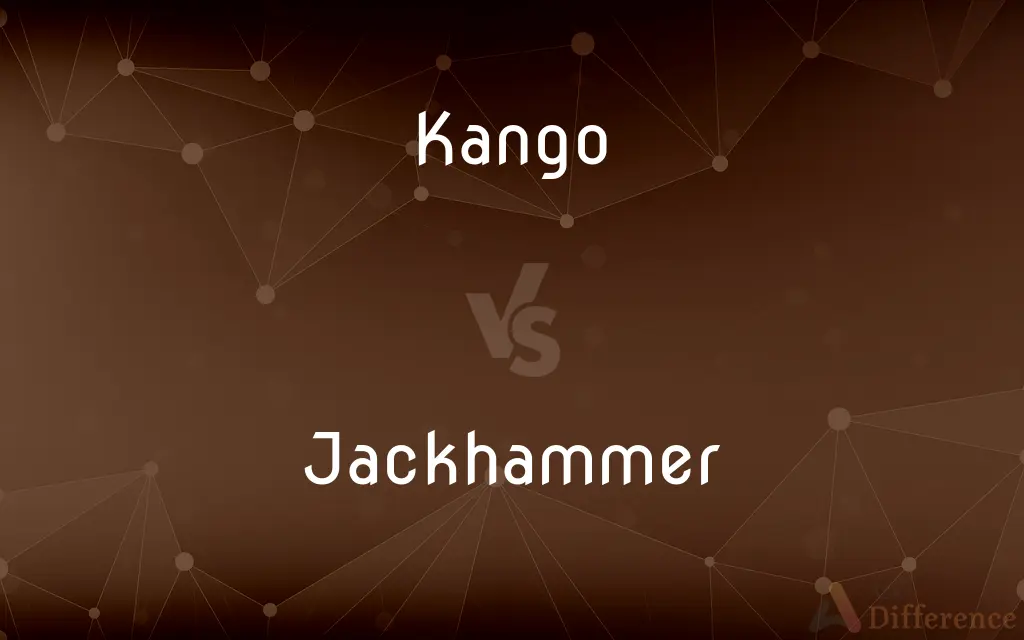Kango vs. Jackhammer — What's the Difference?
By Tayyaba Rehman & Maham Liaqat — Updated on April 25, 2024
Kango is a brand known for its demolition tools, notably rotary hammer drills; whereas a jackhammer is a general term for a pneumatic or electro-mechanical tool used for breaking up rock and concrete.

Difference Between Kango and Jackhammer
Table of Contents
ADVERTISEMENT
Key Differences
Kango is a brand that specifically manufactures power tools suitable for demolition and construction tasks, featuring models like rotary hammers and breakers. Whereas, a jackhammer, which can be powered by air, electricity, or hydraulics, is used broadly in construction for breaking up hard materials like concrete and asphalt.
Kango tools are often versatile, designed to perform a variety of tasks including drilling, hammering, and chiseling with attachments. On the other hand, jackhammers are primarily focused on breaking and demolishing with high impact force and are less versatile.
Many Kango tools include features that reduce vibration and increase user comfort, making them suitable for extended use in various industrial applications. Whereas, traditional jackhammers are heavier and can be more cumbersome, often requiring more physical strength to operate effectively.
Kango often incorporates advanced technology in their tools to enhance performance, such as brushless motors and electronic controls. In contrast, many jackhammers use more traditional technology, focusing on raw power output without as many technological enhancements.
While Kango tools are often used by professionals in construction and renovation who need multifunctional tools, jackhammers are typically used in more heavy-duty demolition work where high power and robustness are the main requirements.
ADVERTISEMENT
Comparison Chart
Primary Use
Drilling, hammering, chiseling
Breaking up hard surfaces like concrete
Power Source
Electric, pneumatic
Pneumatic, electric, hydraulic
Versatility
High (multiple attachments and functions)
Low (primarily for demolition)
Technological Features
Advanced (e.g., brushless motors)
Standard (focus on durability and power)
Typical Users
Professionals in construction and renovation
Used in heavy-duty construction and demolition
Compare with Definitions
Kango
A brand known for producing high-quality power tools for construction.
The contractor recommended a Kango for the upcoming renovation project.
Jackhammer
A heavy-duty tool used primarily for demolition purposes.
The crew used a jackhammer to break up the old concrete patio.
Kango
Known for integrating advanced technology in its design.
Kango tools are appreciated for their brushless motors that enhance durability.
Jackhammer
Known for its robust design and high impact force.
The jackhammer made quick work of the solid limestone.
Kango
Associated with professional grade equipment in the construction industry.
Kango is a popular choice among professional builders for heavy-duty tasks.
Jackhammer
Requires physical strength and endurance to operate.
Operating a jackhammer all day is a physically demanding job.
Kango
Characterized by its user-friendly designs aimed at reducing fatigue.
The new Kango model boasts an improved ergonomic design to reduce user fatigue.
Jackhammer
Operates usually through pneumatic power, though electric models are also common.
They brought in a pneumatic jackhammer for the road work.
Kango
A tool often used for its multi-function capabilities in construction tasks.
He used his Kango to drill holes for the new framing.
Jackhammer
Typically used in construction and demolition sites.
Jackhammers are essential for demolishing large structures efficiently.
Kango
Kango is a town in the Estuaire Province of Gabon, Central Africa, lying on the Komo River and the N1 road. It has a station near the Trans-Gabon Railway, where the railway bridges the Gabon Estuary.
Jackhammer
A jackhammer (pneumatic drill or demolition hammer in British English) is a pneumatic or electro-mechanical tool that combines a hammer directly with a chisel. It was invented by William Mcreavy, who then sold the patent to Charles Brady King.
Kango
A Japanese word of Chinese origin, or a Japanese word coined along Chinese lines (a Sino-Japanese word).
Jackhammer
A handheld machine for drilling rock and breaking up pavement, operated by compressed air.
Jackhammer
A portable percussive power tool that combines a hammer and chisel used to drill or break hard matter, for instance rock or concrete.
Jackhammer
(intransitive) To use a jackhammer.
Jackhammer
(transitive) To break (something) using a jackhammer.
Jackhammer
(transitive) To form (something) using a jackhammer.
Jackhammer
To move like a jackhammer.
Jackhammer
(of the heart or pulse) To beat hard, to pound.
Jackhammer
To move (something) like a jackhammer.
Jackhammer
To strike (something) repeatedly with force, to pound.
Jackhammer
A hammer having a strong steel cutting blade, driven by compressed air in multiple rapid strokes, and used for cutting through pavement, concrete, or other hard substances.
Jackhammer
A hammer driven by compressed air
Common Curiosities
What is a Kango used for?
It's primarily used for drilling, hammering, and chiseling in construction and renovation.
What are the main uses of a jackhammer?
A jackhammer is mainly used for breaking up concrete, asphalt, and other hard materials in demolition projects.
Can a Kango be used as a jackhammer?
Yes, some Kango models can perform similar functions to a jackhammer when equipped with the right attachments.
Are Kango tools interchangeable with jackhammers?
No, Kango tools are generally more versatile with additional functionalities compared to traditional jackhammers.
Is special training required to operate a jackhammer?
Yes, operating a jackhammer safely and effectively typically requires training to handle its weight and vibration, as well as safety precautions.
What makes a jackhammer effective for demolition?
Its high impact force and durable design make it effective for breaking up hard materials.
What safety features are common in Kango tools?
Kango tools often come with anti-vibration technology and ergonomic designs to enhance safety and reduce operator fatigue.
Can jackhammers be used for tasks other than demolition?
While primarily designed for demolition, jackhammers can also be used for breaking up frozen ground, digging holes, or cutting through asphalt in road construction.
What types of power sources are available for Kango tools?
Kango tools can be powered by electricity or pneumatics, offering versatility depending on the job requirements.
How does the weight of a Kango compare to a jackhammer?
Generally, Kango tools are lighter and more manageable than traditional jackhammers, which are heavier and require more physical effort to operate.
Share Your Discovery

Previous Comparison
Jaw vs. Chin
Next Comparison
Premonition vs. VisionAuthor Spotlight
Written by
Tayyaba RehmanTayyaba Rehman is a distinguished writer, currently serving as a primary contributor to askdifference.com. As a researcher in semantics and etymology, Tayyaba's passion for the complexity of languages and their distinctions has found a perfect home on the platform. Tayyaba delves into the intricacies of language, distinguishing between commonly confused words and phrases, thereby providing clarity for readers worldwide.
Co-written by
Maham Liaqat













































